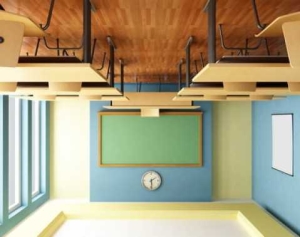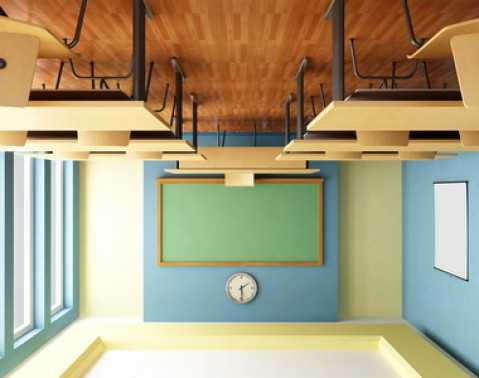Flipped learning and one-to-one are a powerful combo for some populations
 At E.L. Haynes High School in Washington, D.C., 44 percent of students are English language learners, have special needs, or both. Yet all of the students in this urban charter school’s first graduating class have been accepted into college, said Principal Caroline Hill—and she attributed this success to a personalized, self-paced approach made possible by technology.
At E.L. Haynes High School in Washington, D.C., 44 percent of students are English language learners, have special needs, or both. Yet all of the students in this urban charter school’s first graduating class have been accepted into college, said Principal Caroline Hill—and she attributed this success to a personalized, self-paced approach made possible by technology.
E.L. Haynes has a one-to-one laptop program, and students also can bring their own devices to school. Using a flipped learning approach, teachers record their lessons and post them online, so students can watch the content over and over again until they understand—and class time is used to provide more personalized support.
If schools are to meet the learning needs of every student, including those with disabilities, then “we have to think differently about how we provide instruction,” Hill said.
Hill was speaking at a June 17 briefing on Capitol Hill that focused on the intersection of technology and special education. During the event, which was hosted by the National Coalition for Technology in Education and Training, Hill and other educators described how technology is empowering students with disabilities to achieve at high levels.
About 2.5 million children in the U.S. have some kind of learning disability, said Kim Hines, associate director for the National Center for Learning Disabilities. For these children, “technology has been a game changer,” she said, “and for some, it’s been life-changing. … We now know what kids are able to do, and not just what they are unable to do.”
Next page: Tech reduces anxiety
Making learning the constant
At E.L. Haynes, students are able to work at their own pace, Hill said—making learning the constant and time the variable, instead of vice versa. This eliminates the anxiety that students often feel when the teacher moves on to the next topic and they have not learned the previous content.
“For students with disabilities, this anxiety could be the difference between staying engaged in their learning and mastering content,” Hill said, “or disengaging and failing.”
Angela Foreman, a special-education teacher at Jamestown Elementary School in Arlington, Va., said her school has seen “a huge difference” from putting iPads in the hands of students with disabilities.
Like E.L. Haynes, Jamestown has embraced a flipped approach to instruction. This helps with pre-teaching concepts, Foreman said, such as multiplying large numbers. Kids can watch the videos “as many times as they need” the night before a lesson, and Foreman and her colleagues infuse these videos with humor and catchy songs. Then, when students come to class the next day, the teachers start singing those songs—and “the light bulbs come on” for students, she said, stimulating the connective pathways in their brains.
Technology also helps teachers differentiate their lessons for students with disabilities, Foreman said. For instance, teachers can create customized content for students to download and work on independently.
Kate Nagel, a science teacher who works with high-functioning students on the autism spectrum at The Ivy Mount School in Rockville, Md., said her school is using the Science Techbook from Discovery Education. This interactive digital textbook includes features that make the content more accessible for students with disabilities, such as the ability to have the text read aloud to them.
Next page: How more schools can adopt these methods
“This gives students a sense of independence and ownership,” she said, because they no longer have to ask for help.
The Techbook content also includes interactive games and video clips explaining key concepts, which students find engaging, Nagel said. When students are interacting with the content in this way, “they really internalize what they’re learning.”
For instance, her students recently played a game in which they had to build cells and keep out invading viruses. “They remembered every single part of the cell,” she said. “That was not going to happen from just looking at diagrams.”
Relevant for all students
Throughout the briefing, participants noted that these same technologies that are helping students with disabilities to succeed also help other students as well.
By talking about technology and special education, “we’re helping the future of all kids across the country, and not just those with disabilities,” said Alexa Posny, a consultant and former assistant secretary for the Education Department’s Office of Special Education and Rehabilitation Services.
Posny moderated a question-and-answer session at the end of the event, in which she asked participants: What will it take for more schools to adopt these types of changes in their instruction?
Nagel said getting teachers to change their approach can be difficult, because many teachers already feel overworked and resent having technology “pushed” on them as yet another mandate. She recommended that schools encourage instructional shifts by modeling best practices for their teachers.
“Use it yourself, and invite people into your classroom,” she urged teacher leaders. “Make sure other teachers are seeing that, and also seeing the results—(such as) how students are excited to learn.”
Foreman said school leaders should allow teachers to explore technology use on their own in professional development workshops, letting their creativity emerge instead of telling them what to do.
“Let us see what we can do when we’re given the time and the opportunity to do that,” she recommended.
The former Editor in Chief of eSchool News, Dennis Pierce is now a freelance writer covering education and technology. Reach him at denniswpierce@gmail.com.
- TC- What student choice and agency actually looks like - November 15, 2016
- What student choice and agency actually looks like - November 14, 2016
- App of the Week: Science sensor meets your smartphone - November 14, 2016



Comments are closed.